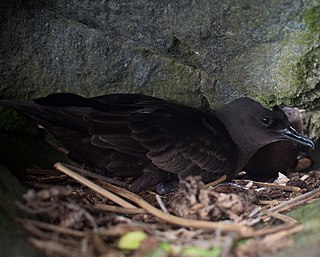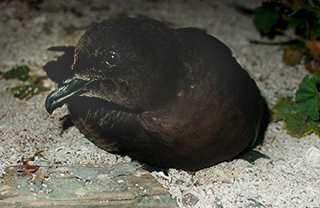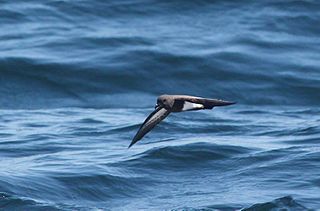
Petrels are tube-nosed seabirds in the bird order Procellariiformes.

Bulwer's petrel is a small petrel in the family Procellariidae that is found in tropical and subtropical regions of the Atlantic, Indian and Pacific Oceans. It is named after the English naturalist James Bulwer.

The band-rumped storm petrel, Madeiran storm petrel, or Harcourt's storm petrel is of the storm petrel family Hydrobatidae.

Bulweria is a genus of seabirds in the family Procellariidae named after English naturalist James Bulwer. The genus has two extant species, Bulwer's petrel and Jouanin's petrel. A third species, the Olson's petrel, became extinct in the early 16th century; it is known only from skeletal remains. Bulwer's petrel ranges in the Atlantic, Indian and Pacific Oceans, whereas Joaunin's petrel is confined to the northwestern Indian Ocean. Olson's petrel is known from the Atlantic.

The Kerguelen petrel is a small slate-grey seabird in the family Procellariidae. It is the only species placed in the genus Aphrodroma. It is a pelagic, circumpolar seabird of the Southern Ocean. It breeds on islands in the southern Atlantic and Indian Oceans.

Pseudobulweria is a genus of seabirds in the family Procellariidae. They have long been retained with the gadfly petrel genus Pterodroma despite morphological differences. Mitochondrial DNA cytochrome b sequence analysis has confirmed the split out of Pterodroma and places the genus closer to shearwaters. They thus represent either a plesiomorphic lineage still sharing some traits of the ancestral Procellariidae with the gadfly petrels, or convergent evolution of a shearwater to the ecological niche of gadfly petrels.

The Saint Helena hoopoe, also known as the Saint Helena giant hoopoe or giant hoopoe, is an extinct species of hoopoe known exclusively from an incomplete subfossil skeleton. Once endemic to the island of Saint Helena, it was last seen around 1550, likely driven to extinction by various aspects of human activity.

Trochetiopsis ebenus, the dwarf ebony or Saint Helena ebony, is a species of flowering plant that is endemic to the island of Saint Helena in the southern Atlantic Ocean. It is not related to the ebony of commerce, but is instead a member of the mallow family, Malvaceae. Saint Helena ebony is now critically endangered in the wild, being reduced to two wild individuals on a cliff, but old roots are sometimes found washed out of eroding slopes. These are collected on the island a used for inlay work, an important craft on Saint Helena. A related species, Trochetiopsis melanoxylon is now completely extinct.
Saint Helena, Ascension Island and Tristan da Cunha, as well the other uninhabited islands nearby, are a haven for wildlife in the middle of the Atlantic Ocean. The islands are or were home to much endemic flora and fauna, especially invertebrates, and many endemic fish species are found in the reef ecosystems off the islands. The islands have been identified by BirdLife International as Important Bird Areas for both their endemic landbirds and breeding seabirds.

The eastern long-eared bat is a small flying mammal, a vespertilionid bat. It is found in eastern Australia and Papua New Guinea.

The white-bellied storm petrel is a species of seabird in the family Oceanitidae. It is found in Angola, Argentina, Australia, Brazil, Chile, Ecuador, French Polynesia, French Southern Territories, Maldives, Namibia, New Zealand, Perú, Saint Helena, and South Africa. Its natural habitat is open seas.

The black-bellied storm petrel is a species of seabird in the family Oceanitidae.

The grey-backed storm petrel is a species of seabird in the austral storm petrel family Oceanitidae. It is monotypic within the genus Garrodia. It is found in Antarctica, Argentina, Australia, Chile, Falkland Islands, French Southern Territories, New Zealand, Saint Helena, South Africa, and South Georgia and the South Sandwich Islands. Its natural habitat is open seas. It is highly attracted to bright lights, especially in conditions of low visibility.

Jouanin's petrel is a species of seabird in the family Procellariidae.

The Tahiti petrel is a medium-sized, dark brown and white seabird found across the Pacifc Ocean. The species comprises two subspecies: P. r. rostrata which breeds in the west-central Pacific Ocean, and P. r. trouessarti which breeds in the tropical and subtropical Pacific Ocean. The Tahiti petrel belongs to the Procellariidae family and is the most studied member of the Pseudobulweria genus which comprises three critically endangered species. Similarly, the Tahiti petrel is considered near threatened by the 2018 IUCN Red List of Threatened Species. Threats include introduced rats, feral cats, pigs, dogs, nickel mining, and light pollution.
The Saint Helena petrel, also known as the Saint Helena gadfly petrel or large Saint Helena petrel, is an extinct species of seabird in the family Procellariidae. It was endemic to the island of Saint Helena in the South Atlantic Ocean. It most likely became extinct after overpredation by people, soon after the island's discovery in 1502. DNA results place it within the group of Atlantic Pterodroma species.















